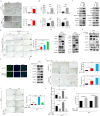S1PR1 regulates ovarian cancer cell senescence through the PDK1-LATS1/2-YAP pathway
- PMID: 37828220
- PMCID: PMC10656284
- DOI: 10.1038/s41388-023-02853-w
S1PR1 regulates ovarian cancer cell senescence through the PDK1-LATS1/2-YAP pathway
Abstract
Cell senescence deters the activation of various oncogenes. Induction of senescence is, therefore, a potentially effective strategy to interfere with vital processes in tumor cells. Sphingosine-1-phosphate receptor 1 (S1PR1) has been implicated in various cancer types, including ovarian cancer. The mechanism by which S1PR1 regulates ovarian cancer cell senescence is currently elusive. In this study, we demonstrate that S1PR1 was highly expressed in human ovarian cancer tissues and cell lines. S1PR1 deletion inhibited the proliferation and migration of ovarian cancer cells. S1PR1 deletion promoted ovarian cancer cell senescence and sensitized ovarian cancer cells to cisplatin chemotherapy. Exposure of ovarian cancer cells to sphingosine-1-phosphate (S1P) increased the expression of 3-phosphatidylinositol-dependent protein kinase 1 (PDK1), decreased the expression of large tumor suppressor 1/2 (LATS1/2), and induced phosphorylation of Yes-associated protein (p-YAP). Opposite results were obtained in S1PR1 knockout cells following pharmacological inhibition. After silencing LATS1/2 in S1PR1-deficient ovarian cancer cells, senescence was suppressed and S1PR1 expression was increased concomitantly with YAP expression. Transcriptional regulation of S1PR1 by YAP was confirmed by chromatin immunoprecipitation. Accordingly, the S1PR1-PDK1-LATS1/2-YAP pathway regulates ovarian cancer cell senescence and does so through a YAP-mediated feedback loop. S1PR1 constitutes a druggable target for the induction of senescence in ovarian cancer cells. Pharmacological intervention in the S1PR1-PDK1-LATS1/2-YAP signaling axis may augment the efficacy of standard chemotherapy.
© 2023. The Author(s).
Conflict of interest statement
The authors declare no competing interests.
Figures






References
MeSH terms
Substances
LinkOut - more resources
Full Text Sources
Medical
Molecular Biology Databases
Miscellaneous

